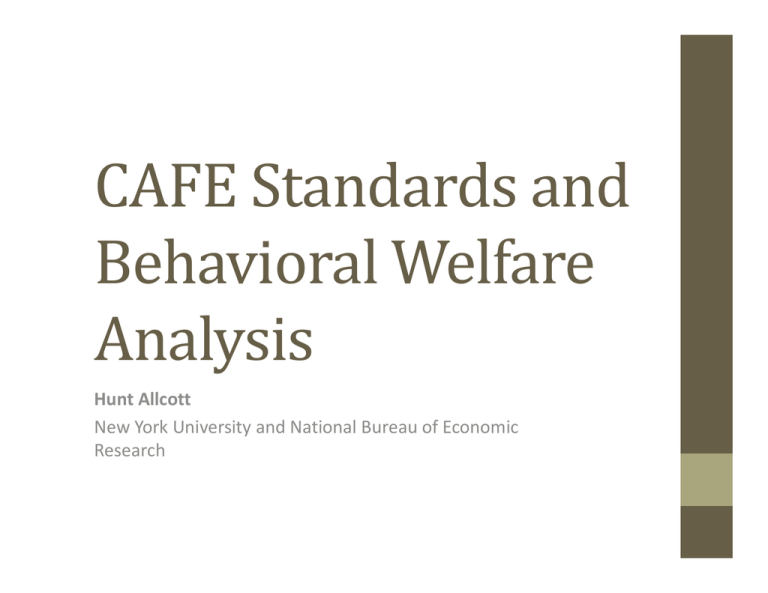CAFE Standards and Behavioral Welfare Analysis Hunt Allcott
advertisement

CAFE Standards and Behavioral Welfare Analysis Hunt Allcott New York University and National Bureau of Economic Research Agenda • • • • • What are internalities? Why internalities are important for CAFE Measuring internalities Behavioral welfare analysis Policy implications 2 What Are Internalities? • Internalities = when consumer WTP for fuel economy is less than their private optima • Example: Hybrid car saves the consumer $3000 in NPV. Is he willing to pay $3000 more for it? • $3000 – WTP = Consumer’s internality • Immediate analogy to an externalities • Could result from: • • • • Imperfect information Systematically downward-biased beliefs about savings Inattention Present bias 3 Internalities: Suggestive Data • After the Vehicle Ownership and Alternatives Survey (Allcott 2011): When purchasing your vehicle, how precisely did you calculate the potential fuel costs? 4 Why Internalities Are Important for CAFE • Potentially a large market failure. Calibration: • If 13% instead of 6% implied discount rate, then internality ≈ 23% of gas costs • If carbon MD = $35/ton, then externality ≈ 10% of gas costs • CAFE is a natural policy response to internalities • Gasoline use externalities => Gas taxes • Congestion externalities => Congestion taxes • Utilization elasticity => CAFE a very bad second best (Jacobsen 2012) • However: Internalities are extensive margin inefficiencies. • (As commonly proposed, if they exist.) • => Feebates (or “stylized CAFE”) are the optimal tax policy • Internality reduction already used to justify CAFE 5 Justifying CAFE by Internalities 2010 CAFE FRIA • Total Benefits: $146 billion • Externality Benefits: $18 billion • Gross Private Benefits: $128 billion • Total Costs: $52 billion • Net Private Benefits: $76 billion 6 Justifying CAFE by Internalities "Although the economy-wide or "social" benefits from requiring higher fuel economy represent an important share of the total economic benefits from raising CAFE standards, NHTSA estimates that benefits to vehicle buyers themselves [original emphasis] will significantly exceed the costs of complying with the stricter fuel economy standards this rule establishes . . . However, this raises the question of why current purchasing patterns do not result in higher average fuel economy, and why stricter fuel efficiency standards should be necessary to achieve that goal. To address this issue, the analysis examines possible explanations for this apparent paradox, including discrepancies between the consumers` perceptions of the value of fuel savings and those calculated by the agency . . . “ 7 -CAFE Standard Final Regulatory Impact Analysis (2010) Measuring Internalities • Broader literature in economics on measuring inattention, biased beliefs, and present bias; see DellaVigna (2009) • Example: Evidence on inattention from other domains • Prices vs. sales taxes: Chetty, Looney, and Kroft (2009) • Prices vs. shipping and handling: Hossein and Morgan (2006) • Insurance premiums vs. out-of-pocket costs: Abaluck and Gruber (2011) • => Suggest that inattention might be relevant for gas costs • Four approaches to measuring internalities • Engineering analysis • Logic like CAFE RIA or McKinsey curves: Failure to adopt a (truly) profitable investment implies some market failure • Comparing elasticities • Manipulating salience • Belief elicitation 8 Comparing Elasticities • Intuitive approach: Hausman (1979) air conditioners • Compare price elasticity to PDV energy cost elasticity • Vij = -η(Price+γGasCost) + βOtherCharacteristicsj + ξj • Vij = Utility from vehicle j, ξ=Unobserved quality • What if GasCost correlated with ξ? Omitted variables bias! 9 Comparing Elasticities • Panel identification: Allcott and Wozny (2012), Busse, Knittel, and Zettelmeyer (2013), and Sallee, West, and Fan (2009). • Implied discount rate results: • AW: 15%. BKZ: 13% average (report a range from -6.8 to 20.9%). • 6% opportunity cost of capital = > 0.76 to 0.78 “valuation weight” 10 Comments: Comparing Elasticities • Assumptions: Product lifetime, utilization, (true) discount rate, energy price forecasts • Changes in preferences associated with energy price trends • Sticky information vs. undervaluation • Measurement error • Endogenous utilization 11 Manipulating Salience • Allcott and Taubinsky (2013): Treatment effects of 0 ($-0.30,$+0.35) and ~$2.50 per CFL. • Also Allcott and Knittel (autos, in progress) 12 Comments: Manipulating Salience • Advantage: Avoid empirical challenges of the “comparing elasticities” approach • Measurement error, discounting assumptions, etc. • Key concern: Can we interpret treatment effects as bias? • Demand effects • Information understood, believed, and internalized? • External validity • Info provision addresses particular kinds of biases • Joint test of information and inattention • Does not test for present bias 13 Belief Elicitation • 2010 CAFE RIA: Consumers have incorrect “perceptions” of the value of fuel savings • Vehicle Ownership and Alternatives Survey (Allcott 2013) • On average, consumers correctly estimate or slightly underestimate fuel costs between vehicles. 14 Comments: Belief Elicitation • Problems: • Stated beliefs, not market choices • Stated beliefs vary widely: Outliers matter for the mean • Incentivize response effort without additional calculation • Benefit: Isolate the effect of biased beliefs 15 Behavioral Welfare Analysis • There is a broader literature on “behavioral welfare analysis” • Highly cited/thoughtful guidance: Bernheim and Rangel (2009) • Must make assumptions to separate “welfare-relevant” from “suspect” choices • i.e. translate from “decision utility” to “experienced utility” • Examples: • Comparing elasticities: Price elasticity is welfare-relevant, energy cost elasticity is suspect. • Manipulating salience: Informed decisions welfare-relevant, control (baseline) decisions suspect • Allcott and Taubinsky (2013) detail welfare analysis • Belief elicitation: True data are welfare-relevant, beliefs are suspect • Allcott (2013) details welfare analysis • Next slides: Graphical welfare analysis 16 WTP for a Gas Guzzler P Total WTP a p+G G p Q 17 Standard Model: Effect of a Tax P Total WTP b τ a p+G G p Q 18 Equilibrium with Internalities P Total WTP p+G a p+γ∙G G c γ∙G p Q 19 Effect of an Internality Tax P Total WTP p+G a τ=(1-γ)∙G p+γ∙G G c γ∙G p Q 20 Welfare Implications P Total WTP G and c saved Q 21 Welfare Implications P Total WTP Hedonic CS Loss Q 22 Internality Tax Welfare Gains P Total WTP Welfare Gain Q 23 Policy Implications • Heterogeneity and targeting matters for welfare analysis • Internalities (if they exist) should be heterogeneous • CAFE distorts unbiased consumers even as it improves allocations for misoptimizers (O’Donoghue and Rabin 2006). • Intuitive evidence that CAFE is poorly targeted: • Environmentalists probably more attentive to gas costs • CAFE => more hybrids, but environmentalists buy hybrids! • => CAFE could actually reduce welfare through bad targeting • Empirically challenging due to lack of proxy for internality • Correctly calibrate magnitudes • CAFE standard much stricter than optimal given estimated belief bias (Allcott 2013). • Allcott (2013) calibration takes choice set as given. Future research should combine estimated internality with fleet development model. 24 Takeaways • Understanding internalities (or the lack thereof) is extremely important for setting and evaluating CAFE standards • Four ways to estimate internalities, each with advantages and disadvantages • • • • Engineering analysis Comparing elasticities Manipulating salience Belief elicitation • Leverage existing framework for behavioral welfare analysis • Bernheim and Rangel (2009), Allcott (2013), and Allcott and Taubinsky (2013) • Policy implications: • Targeting: Must consider not just how much gasoline is saved, but who is saving gasoline • Magnitudes: Make sure that empirical estimates of internalities justify policy magnitudes 25




